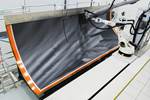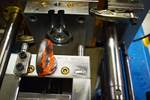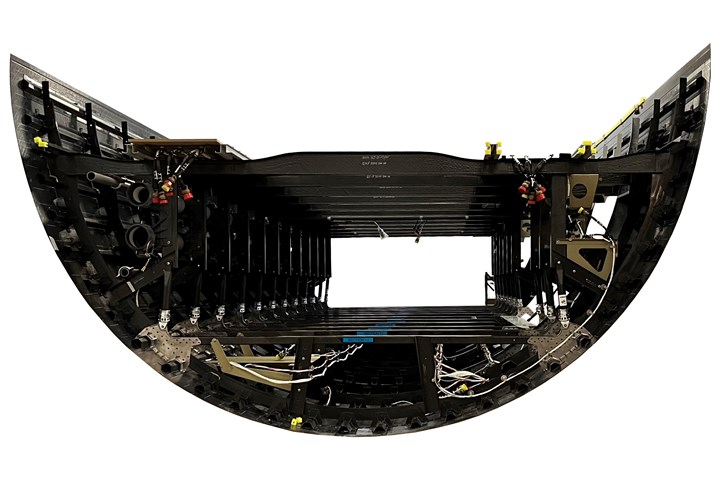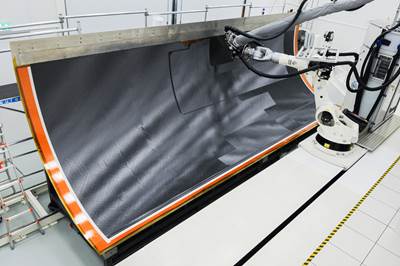STUNNING project completes lower half of MFFD
Clean Sky project has delivered the 8 × 4 meter welded aerostructure component, aided by advanced thermoplastic composite technologies and smart robotics.
GKN Fokker (Papendrecht, Netherlands), Netherlands Aerospace Centre (NLR, Amsterdam, Netherlands) Delft University of Technology (TU Delft, Delft, Netherlands) and SAM|XL (Delft, Netherlands) have successfully completed the manufacture of the lower fuselage section of the Multifunctional Fuselage Demonstrator (MFFD), a project led by Airbus (Tolouse, France). The 8 × 4-meter composite structure, reported to be one of the world’s largest thermoplastic components, was delivered under the Clean Sky 2 STUNNING project.
The MFFD is an 8-meter-long fuselage barrel that will be made from welded thermoplastic composites, STUNNING being one dozens of individual projects and work packages involved in its completion. Ultimately, the project demonstrates how the use of thermoplastic composites can help realize a next-gen fleet of aircraft capable of offering the same strength and durability as aluminum, while drastically reducing the fuselage recurring cost, as well as the overall weight of aircraft and the subsequent emissions. (CW has reported extensively on the MFFD, see “Proving out LMPAEK welding for Multifunctional Fuselage Demonstrator” and “Moving forward on the Multifunctional Fuselage Demonstrator (MFFD).”)
The aerostructure consists of more than 400 fiber-reinforced thermoplastic parts, as well as thousands of spot welds and hundreds of meters of continuous welds (read “Thermoplastic composites welding advances for more sustainable airframes”). The fuselage lower half will be joined at Fraunhofer IFAM in Stade — as of February 2023, the upper shell skin was completed — with the upper half made by German Aerospace Center (DLR) Institute of Structures and Design in Augsburg.
The MFFD project aims to demonstrate high-rate production (HRP) of a minimum of 60 aircraft per month (up to 100 aircraft), reduce the total fuselage weight by 1 ton (10%) and reduce the total fuselage recurring cost by €1 million (20%). STUNNING contributed to these objectives by showcasing novel thermoplastic manufacturing and joining technologies, as well as modular manufacturing techniques and automation.
GKN Fokker was responsible for the assembly of STUNNING, which consisted of a skin module and a floor grid module. The skin module featured a skin made as a single part by NLR using automatic fiber placement (AFP), 38 stringers from Xelis made using continuous compression molding, some of which joggled by NLR, 208 injection-molded clips produced by the ECO-CLIP consortium and frame sub-assemblies.
The floor grid module included floor beam subassemblies with passenger floor beams made via AFP. Both frame and floor beam subassemblies were made by GKN Fokker. The floor grid was fully equipped with various systems before installation in the skin module.
“This breakthrough project, which began in 2017, has significantly advanced our understanding and accelerated the development of thermoplastic technologies for large and complex aircraft parts,” Arnt Offringa, director of GKN Aerospace’s Global Technology Center NL. “It has showcased the potential for industrial-scale application of robotic welding in the assembly of thermoplastic aerostructures. The partnership approach to STUNNING has also been a great success, showing how much progress can be made when working together. Collaboration projects such as this will be vital as we continue to push the boundaries of technology in order to meet our sustainability targets.”
The demonstrator was assembled in SAM|XL at the TU Delft Campus, where a 10 × 11 × 4-meter ultrasonic welding robot was built from numerous machine parts and software components supplied by European partners. Team SAM|XL was responsible for the integration of the robotic welding cell and the development of smart control and programming methods. Valuable lessons were learned related to “design for automated assembly.”
In a joint effort, rapid energy-efficient ultrasonic welding technology was scaled-up from the lab at the Faculty of Aerospace Engineering to an industrial-scale solution for dustless assembly of the demonstrator involving 1,600 structurally sound spot welds. Further maturation of this game changing assembly technology will be accelerated in SAM|XL’s new robotic welding lab.
Related Content
The lessons behind OceanGate
Carbon fiber composites faced much criticism in the wake of the OceanGate submersible accident. CW’s publisher Jeff Sloan explains that it’s not that simple.
Read MoreInfinite Composites: Type V tanks for space, hydrogen, automotive and more
After a decade of proving its linerless, weight-saving composite tanks with NASA and more than 30 aerospace companies, this CryoSphere pioneer is scaling for growth in commercial space and sustainable transportation on Earth.
Read MoreBio-based acrylonitrile for carbon fiber manufacture
The quest for a sustainable source of acrylonitrile for carbon fiber manufacture has made the leap from the lab to the market.
Read MorePlant tour: Albany Engineered Composites, Rochester, N.H., U.S.
Efficient, high-quality, well-controlled composites manufacturing at volume is the mantra for this 3D weaving specialist.
Read MoreRead Next
STUNNING project successfully develops 8.5-meter thermoplastic fuselage skin
Clean Sky 2 project under the MFFD program produces two segments of an 8.5-meter-long, 4-meter-diameter thermoplastic fuselage skin via NLR’s in-house AFP machine, with consolidation plans this summer.
Read MoreINN-PAEK project to develop 100% recyclable, lightweight thermoplastic flange wheels for future aircraft
The AITIIP Technology Center leads this research with partner Liebherr Group to develop a technology by June 2023 that contributes to more sustainable, eco-friendly production systems.
Read MoreVIDEO: High-volume processing for fiberglass components
Cannon Ergos, a company specializing in high-ton presses and equipment for composites fabrication and plastics processing, displayed automotive and industrial components at CAMX 2024.
Read More



























